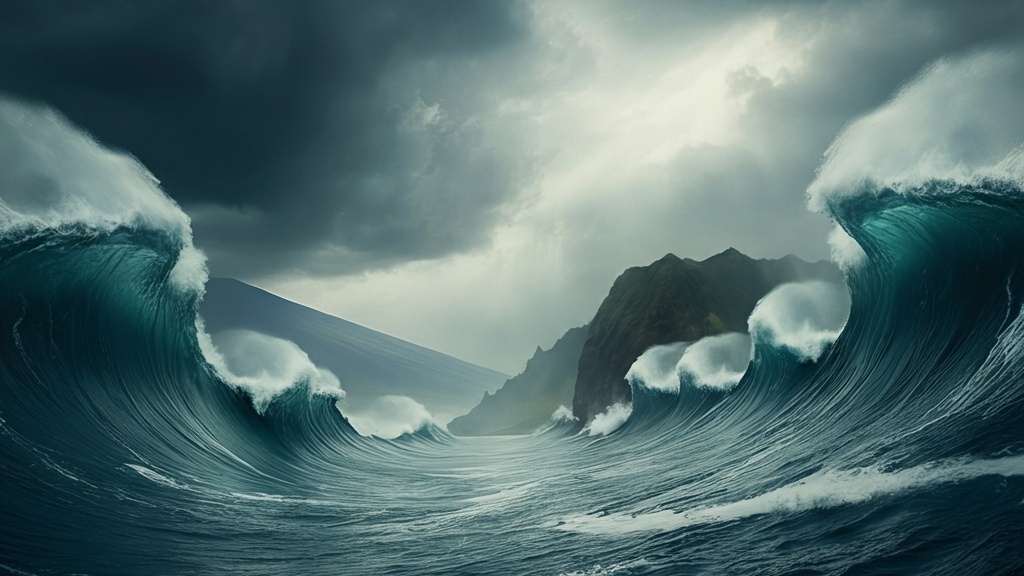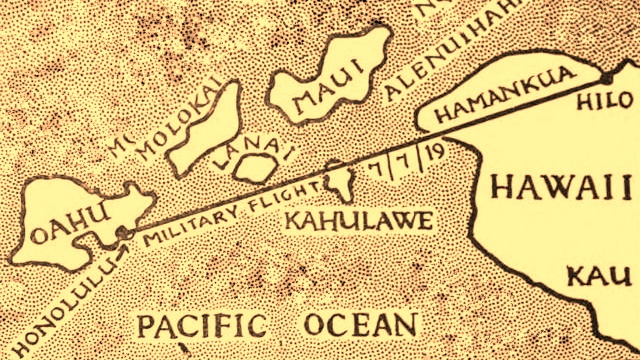Visitors flying between Maui and the Big Island have no idea they are over one of Hawaii’s most deceptively dangerous ocean stretches. The 30-mile-wide Alenuihaha Channel—whose name roughly translates to “great billows smashing”—has long been considered Hawaii’s most treacherous interisland crossing. Even experienced sailors and paddlers speak of it with respect, and sometimes fear. We know why—we experienced it during gale-force warnings on the sea.

Strong trade winds, funneled between towering volcanic landmasses, combine with powerful ocean currents and underwater ridges to create an unpredictable—and sometimes violent—situation. Swells can build quickly and cross each other, creating confused seas that can capsize even seasoned boaters.
Pictured on this old public domain map, it’s so dangerous that ancient Polynesians, who navigated thousands of miles across the Pacific, often avoided this route. Today, it remains a defining test for bluewater sailors—and a source of unexpected drama for some Hawaii cruise passengers too.


An incredibly stormy night on board: what we experienced.
We once crossed from Maui to Big Island aboard a small expedition ship, and on that unforgettable night, the Alenuihaha Channel showed us exactly why it’s so feared.
The swells were extreme enough that standing up was virtually impossible. It was, in fact, barely possible to stay in bed—seatbelts would have been appropriate. Crew members placed towels along the floor to absorb water sloshing from the bathroom sinks. Drawers slammed open and closed as the boat heaved in the dark. This went on for many hours, incessantly.
At one point, we heard a crash and discovered a fellow passenger’s suitcase had launched across the ship. The crew remained calm and professional, but even they acknowledged it had been a rough crossing. And while we wouldn’t trade the experience, we also wouldn’t describe it as relaxing.
Yes, it’s still part of the cruise.
Despite the risk, UnCruise—where we experienced this crossing—still includes the Alenuihaha Channel in its interisland route, advertising it as part of their Hawaii Seascapes adventure between Molokai and the Big Island. We verified that the Safari Explorer continues to make this crossing, and recent guest accounts confirm the passage remains dramatic and unpredictable.
One traveler recounted a smooth sunset crossing. Another, in contrast, wrote that the waves were so intense it felt like “being in a washing machine.” The range of experiences reflects the channel’s inherent volatility—what looks glassy one day can become unruly the next.
On calm days, the channel rewards travelers with breathtaking views of both islands. It’s not uncommon to spot dolphins or whales mid-crossing, as is also the case in Drake’s Passage. It’s a rare part of Hawaii cruise adventures that blends remoteness, raw power, and incredible beauty.
Hawaii’s overlooked rescue zone.
While not as infamous as the Kalalau Trail or the backcountry of Maui’s Haleakala crater, the Alenuihaha Channel is right up there with adventure. Small boaters who underestimate the channel’s force or are caught in deteriorating conditions up to gale force sometimes require airlift or rescue, especially during summer when trade winds intensify.
There are no bridges or ferries between Maui and the Big Island. The only way across is by flight—or via the ocean, if you’re prepared to risk it. And many who try the latter aren’t.
Though data is limited, Coast Guard reports in recent years confirm several rescues and capsized vessels in the Alenuihaha, including kayakers, fishing boats, and at least one unprepared recreational sailor. Each event strains Hawaii’s overextended rescue infrastructure, highlighting how even short interisland travel can quickly turn dangerous.
The Alenuihaha Channel also played a central role in the downfall of Hawaii’s short-lived interisland ferry. When the Hawaii Superferry launched service between Oahu and Maui in the mid-2000s, critics quickly pointed to the channel’s rough waters as a major obstacle to expansion.
In online forums and public protests, residents described the ride as a “vomit comet.” They cited unpredictable wave patterns and strong winds as reasons the service was untenable, especially for routes to the Big Island.
One commenter wrote, “The current between Maui and the Big Island is the most treacherous in the world. Even taking a ship is dangerous.” Others cited crisscrossing swells from multiple directions, making the seas “sloppy” and disorienting even for experienced mariners.
Ultimately, the Superferry was scrapped amid legal battles, environmental concerns, and logistical headaches, leaving the Alenuihaha as a reminder that not every great idea can sail smoothly here in Hawaii.
Is this Hawaii’s version of the Drake Passage?
In global terms, the Alenuihaha Channel has been compared—at least in miniature—to the Drake Passage, located between South America and Antarctica. That stretch of ocean is known for deadly winds, rogue waves, and punishing 48-hour ship crossings. That makes our eight-hour Alenuihaha seem like child’s play. Still, while Hawaii’s waters don’t reach the same extremes, the parallels are worth noting.
Both passages are shaped by narrow geography and strong wind corridors. Both see major ocean current collisions. Both are capable of generating waves far larger than one expects. And both have humbled travelers who thought they were prepared.
The Alenuihaha may be shorter and less remote, but its impact can be just as sudden and severe.
What this means for Hawaii travelers.
Most visitors flying from Maui to the Big Island might never have given this channel a second thought before reading this. But it deserves one. Whether you’re planning to fly, sail, or cruise in these waters, the risks are not theoretical, and the Alenuihaha commands respect.
If you’re joining a small ship expedition like UnCruise, talk to the crew about what to expect and what weather windows look safest. Over the years, they’ve become experts here. If you’re considering private boating, don’t underestimate the need for experience and backup plans. This is not a channel for testing luck.
Even for those not venturing onto the water—and flying 15,000 feet above it—the Alenuihaha reminds us that Hawaii’s natural beauty often hides enormous power and real danger. The very elements that shaped these islands continue to shape how we experience them—sometimes gently, sometimes forcefully.
One of Hawaii’s most humbling forces.
While the Alenuihaha Channel won’t appear on most Hawaii visitor itineraries, it isn’t romanticized in guidebooks or splashed across Instagram reels. But for those who know it, and those who’ve crossed the channel, it stands as one of Hawaii’s most humbling natural forces.
While it may not carry the cinematic significance of Antarctica’s Drake Passage, it has something else: a quiet, understated power that reflects the raw side of Hawaii—where ancient voyagers paused, modern travelers still struggle, and nature always decides who gets to go across.
Have you crossed the Alenuihaha Channel—or would you? Tell us your journey or what you’d want to know before making it.
Get Breaking Hawaii Travel News









